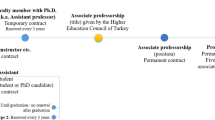Abstract
We analyze the relation between funding and output using bibliometric methods with field normalized data. Our approach is to connect individual researcher data on funding from Swedish university databases to data on incoming grants using the specific personal ID-number. Data on funding include the person responsible for the grant. All types of research income are considered in the analysis yielding a project database with a high level of precision. Results show that productivity can be explained by background variables, but that quality of research is more or less un-related to background variables.
Similar content being viewed by others
References
Braun, T., Glänzel, W., Schubert, A. (1990), Publication productivity: from frequency distributions to scientometric indicators. Journal of Information Science, 16: 37–44.
Braun, T., Glänzel, W. (1990), United Germany: The new scientific Superpower? Scientometrics, 19(5–6): 513–521.
Braxton, J., Bayer, A (1986), Assessing faculty scholary performance. In: Creswell (Ed.), Measuring Faculty Research Performance: New directions for institutional research, 50, Jossey-Bass, San Francisco, 5–14.
Dietz, J. S., Chompalov, I., Bozeman, B., Lane, E. O., Park, J. (2000), Using the curriculum vita to study the career paths of scientists and engineers: an exploratory assessment. Scientometrics, 49(3): 419–442.
Dietz, M., Bozeman, B. (2005), Academic careers, patents, and productivity: industry as scientific and technical human capital. Research Policy, 34: 349–367.
Dundar, H., Lewis, D. R. (1995), Departmental productivity in American Universities. Economics of Education Review, 14(2): 119–144.
Fox, M. F. (1983), Publication productivity among scientists: A critical review. Social Studies of Science, 13: 285–305.
Fox, M. F. (1992), Research, teaching, and publication productivity: mutuality versus competition in academia. Sociology of Education, 65: 293–305.
Glänzel, W. (1996), The need for standards in bibliometric research and technology. Scientometrics, 35: 167–176.
Merton, R. K. (1961), Social Theory and Social Structure. Free Press, Glencoe, IL.
Moed, H. F. (2005), Citation Analysis in research Evaluation. Springer Verlag.
Nederhof, Visser (2004), Quantitative deconstruction of citation impact indicators. Journal of Documentation, 60: 658–672.
Porter, S., Umbach, P. (2001), Analyzing faculty workload data using multilevel modeling. Research in Higher Education 42: 171–176.
Print, M., Hattie, J. (1997), Measuring quality in universities: An approach to weighting research productivity. Higher Education, 33: 453–469.
Van Raan A. F. J. (2004), Measuring science: Capita selecta of current main issues. In: H. F. Moed, W. Glänzel, U. Schmoch (Eds), Handbook of Quantitative Science and Technology Research, Dordrecht: Kluwer Academic Publishers, 2004.
Van Raan A. F. J. (2006), Statistical properties of bibliometric indicators: Research group indicator distributions and correlations. Journal of the American Society for Information Science and Technology, 57(3): 408–430.
Sandström, U., Hällsten, M., Heyman, U. (2005), Svensk forskningsfinansiering: inriktning och styrning (revised version 2005-12-08), Stockholm: Vetenskapsrådet.
Sandström, U., Hällsten, M. (2008), Persistent nepotism in peer review. Scientometrics, 74(2) 175–189.
Schubert, A., Braun, T. (1996), Cross-field normalization of scientometric indicators. Scientometrics, 36: 311–324.
Stephan P. E., Levin, S. G. (1992), Striking the Mother Load in Science. Oxford University Press, New York.
Stephen, R., Porter, Umbach, Paul D. (2001), Analyzing faculty workload data using multilevel modeling. Research in Higher Education, 42(2).
Toutkousinan, R., Dundar, H., Becker, W. (1998), The National Research Council graduate program ratings: What are they measuring? Review of Higher Education, 21: 427–443.
Toutkousinan, R., Porter, S. R., Danielson, C. Hollis, P. R. (2003), Using publications counts to measure an institution’s research productivity. Research in Higher Education, 44: 121–48.
Author information
Authors and Affiliations
Corresponding author
Rights and permissions
About this article
Cite this article
Sandström, U. Research quality and diversity of funding: A model for relating research money to output of research. Scientometrics 79, 341–349 (2009). https://doi.org/10.1007/s11192-009-0422-2
Received:
Published:
Issue Date:
DOI: https://doi.org/10.1007/s11192-009-0422-2




